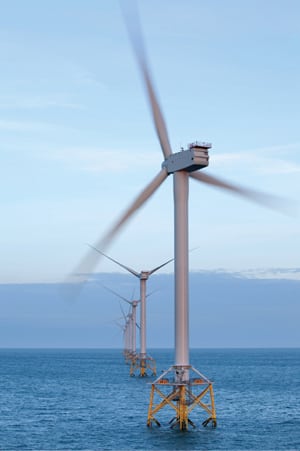Two New Offshore Farms Turning Despite Stagnant Global Wind Market
The UK opened two massive offshore wind farms this February on the Irish Sea off the UK’s Cumbrian coast. DONG Energy, SSE, OPW, and a consortium of Dutch pension fund service provider PGGM and Ampere Equity Fund began commercially operating the 367-MW Walney wind farm, estimated to cost $1.58 billion, and Danish wind firm Vattenfall inaugurated the Ormonde Offshore Wind Farm.
Walney uses 102 Siemens turbines that were installed in a record five months 15 kilometers (km) off Walney Island. The development included foundations, turbines, export and array cables, offshore substations, and onshore connection to grid.
Vattenfall’s 8.6 square-km wind farm, located about 10 km from the Barrow-in-Furness shore in the Irish Sea, comprises 30 5-MW REpower wind turbines and is expected to generate 500 GWh annually (Figure 6). The two-year-long project is unusual because it uses fairly new technology. Only six REpower 5-M turbines have been so far installed in the German test field alpha ventus, partly owned by Vattenfall, and two others in the Beatrice demonstration test field in the UK. The turbines, with a rotor diameter of 126 meters and three rotor blades—cover the area of two soccer fields. Each nacelle is the size of two houses.
 |
| 6. The wind’s changing course. Vattenfall in late February completed commissioning work on its 30th turbine of the Ormonde Offshore Wind Farm off the UK’s Cumbria coast. The facility is expected to generate 500 GWh annually. Courtesy: Vattenfall |
The wind farms are part of the UK’s efforts to boost its power capacity to 18 GW by 2020 to meet increasing demand for energy and to meet European Union (EU) renewables targets and cut emissions 34% from 1990 levels. The UK already has more than 1,500 MW of nameplate offshore wind capacity, and it plans to spend billions of dollars more to increase offshore generation more than 10-fold by 2020, Bloomberg reported in February.
According to European renewables think tank EurObserv’ER, however, key wind energy markets like the UK “may be showing fault lines.” Asia was the world’s biggest wind market in 2011, taking a 52% share, ahead of Europe (24.5%) and North America (19.7%), it says in a newly released study. Though Europe had the largest wind power capacity in the world with 40.6% of the world’s total in 2011, it “attracts less than a quarter of the newly installed capacity and could be overtaken by Asia in 2012.”
The EU market is “wavering between the flagging onshore market and the logistics, technology and industrial preparations for the huge, offshore wind energy market with its rich pickings,” the study says. The EU market could further decline on the back of delayed loans stemming from the recession. Moreover, many governments have reduced domestic market growth both with slowed permitting and increased administrative procedures (Spain’s preallocation plan, for example).
Even China, the world’s biggest wind power market, saw installations level off for the first time in 2011, EurObserv’ER says. This was due to a slew of new regulations imposed by Chinese authorities in a bid to improve control over growth of the country’s domestic renewable energy market. Some regulations, for example, divest China’s provinces of their independence to decide on the siting of wind farms of less than 50 MW. Projects now require government approval in consultation with the grid operator. New technical standards have also been imposed to facilitate grid integration of wind turbines.
The U.S. wind sector’s long-term development, meanwhile, hangs in the balance for lack of agreement on continuation of the current incentive system, which consists of a production tax credit of 2.2¢ per kWh for wind generation, the study notes.
Globally during 2011, offshore wind power fared the worst, EurObserv’ER says. Only 788.1 MW were installed, compared to 1,139 MW in 2010. “The decline recorded in 2011 however, will not drive the off-shore sector’s future development off course,” it forecasts, saying 18 projects under construction should be completed over the next three years and raise the EU’s offshore capacity to more than 9 GW. “The sector’s growth is set to accelerate from then on,” it concludes, citing claims that 40 GW of offshore capacity should be installed by 2020, which will cover 4% of the EU’s electricity demand.
—Sonal Patel is POWER’s senior writer.